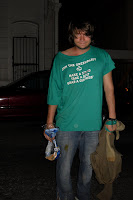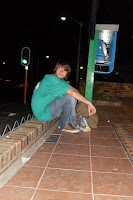

Male violence is common throughout the world. Media use male violence to represent masculinity in many cases such as action movies. (O’shaughnessy & Stadler 2007: 357). Violence is often used as a problem solving strategy towards other men, woman, children, animals, objects etc.Violence is one of the main issues the world, especially South Africa, facing.
O’shaughnessy & Stadler also refer to ‘self-destruction’, violence is not always towards other people. This is found in the culture of sport - ‘No pain, no gain.’
(She has been a victim of a possible 'problem solving strategy')
O’shaughnessy, M & Stadler, J. 2007. Ideologies and Discourses of Masculinity. In: Media and Society. Oxford University Press.
Reference list for my Blog:
Berger, J. Chapter 3. In: Ways of seeing. London: Penguin. 1972.
Entwistle, J. 2000. Chapter 1. Addressing the Body. In: The Fashioned Body. Cambridge: Polite Press
Flicr (2010). Fokofpolisiekar – Francois van Coke. [Online image] Availbe from http://www.flickr.com/photos/81217723@N00/2089822122 [Accessed 12/10/10].
Howson, A. 2004. Chapter 4: The Body in Consumer Culture. In: The Body in Society. Cambridge: Blackwell Press.
Meganshead (2010). The Soli Story. [Online image] Available from http://www.meganshead.co.za/?tag=soli-philander [Accessed 12/10/10].
O’shaughnessy, M & Stadler, J. 2007. Feminism, Postfeminism and Ideologies of Femininity. In: Media and Society. Oxford University Press.
O’shaughnessy, M & Stadler, J. 2007. Ideologies and Discourses of Masculinity. In: Media and Society. Oxford University Press.
WEST CAPE NEWS (2010). Juvenile criminals fall through chasm of state ineptitude. [Online image] Available from: http://westcapenews.com/?p=1706. [Accessed 07/10/10























